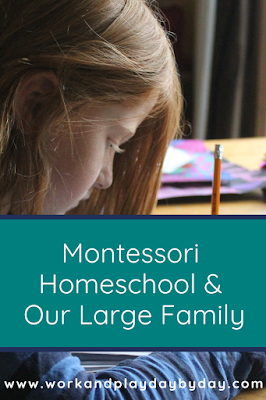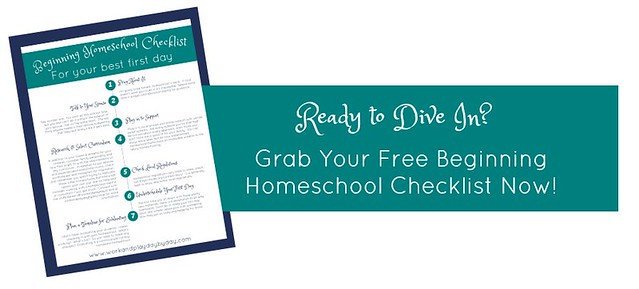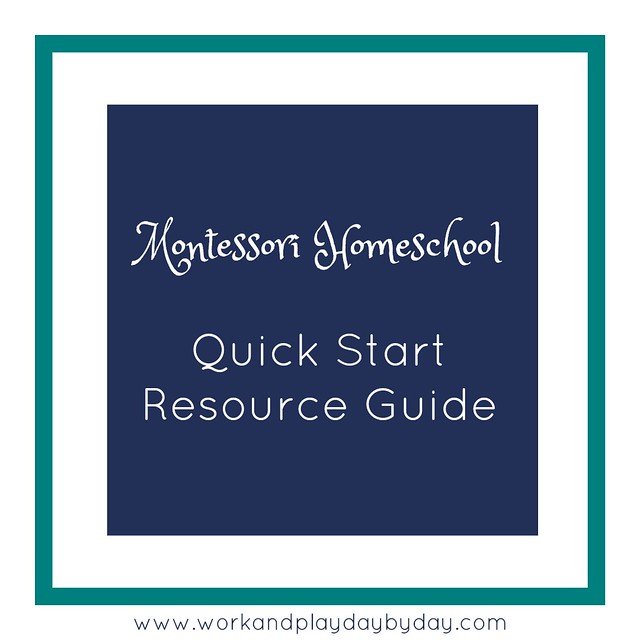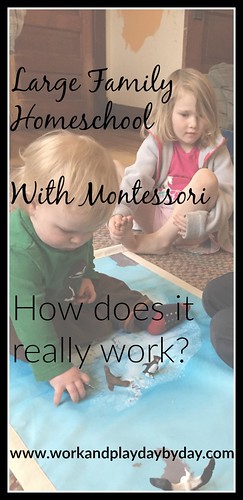People I meet at homeschool events always seem impressed when they hear we use Montessori at home. Everyone seems to have heard of it, usually through online sources, but it always seems like this far away distant thing that could never work for them. People ask me to tell them more, but I am pretty sure I have yet to inspire a friend in real life to tackle Montessori with their large family! Online, it seems that the majority of bloggers incorporating Montessori have no more than 2-3 children within a smaller age range.
I can admit that Montessori homeschool, particularly with a large family, is a little intimidating and as I have said before takes a lot of planning and organization on the side of Mom. Having a prepared environment is difficult if mom doesn’t have the time or the knowledge to prepare it! I thought it might be interesting to give you a bit of a glimpse into just why we choose this approach and how it fits in with our larger family lifestyle.
Why do we do it?
I won’t focus on the reasons we homeschool here, or even why we chose the Montessori method, but rather why we believe it is compatible with our family goals. That is actually the first reason: Montessori is a lifestyle method of education. Practical life is included in the curriculum and we would want to teach those skills regardless. Montessori provides a framework for continuing to learn about activities of daily life, handwork, and other practical skills we would like our children to learn. Practical life does not stop with preschoolers!
Montessori is also naturally collaborative. The entire method is designed for a mixed age setting, which we obviously have. Leadership is developed as children relate in mixed ages to those younger and older than themselves. Our large family gives us the ability to incorporate things like reading buddies, even without other classrooms. Older children are prepared to present sensorial lessons to younger ones, or to read a story, while mom works with another child. Since the focus is not on accomplishing a set of pages or skills each day, these activities are considered a productive use of time and not something that prevents an older child from completing his/her work. This is their work too!
What are some of the challenges?
Our largest challenge with Montessori specifically with a larger family is space. Space is a challenge all Montessori homeschooling families face, but for use we have to have many levels of materials available at all times. I have rarely had the opportunity to put one work away before needing it available for another child. I have infant/toddler materials, children’s house materials, and both lower and upper elementary materials! I also have a high schooler that is transitioning into a different style as well. That is a lot of keep organized and managed. I have to make choices and adaptations to make materials stretch for a variety of purposes. In addition to organizing those materials, we have to deal with more than the occasional baby or toddler sitting down on top of our lesson presentations and grabbing materials with many pieces and unceremoniously dumping them.
The biggest challenge beyond materials, is being complete and keeping track of the curriculum. I often make concessions to the curriculum for things like our hierarchical materials to present to the maximum number of children as opposed to repeating a one time lesson every year or two. Knowing where each child is in comparison to the sequence of presentations in each subject area makes my brain hurt when I think about it too hard! I’m continually refining my own spreadsheets based on the materials we have that I can use to track everyone better.
What do we gain?
In addition to the built in collaboration and advanced practical life mentioned above, the biggest benefit we see is probably cost savings. Most Montessori homeschoolers at this point are saying, WHAT? I don’t save any money! Those materials are expensive! Indeed they are, but in this case it is a little like cloth diapers. If you buy top of the line and only use them for one or two children, you maybe don’t see the savings over disposable. In the case of our large family, however, the savings add up every year. I could probably homeschool for no upfront cost for several years if I wanted to and provide the same education I have this far for everyone else. Our sandpaper letters cost $35 and will be a part of teaching all 6 children (so far) letters and sounds. Compare that to beginning letter sounds workbook at an average cost of $10 (for something not from the dollar store) and my savings grow each year.
Montessori also emphasizes independence in care of self, something that cannot be over emphasized in its benefits to a large family! Mentoring is also an important piece that nurtures the relationships between my older and younger family members.
What does a typical day look like?
Our typical day is probably very similar to those of other homeschooling families. I am an early bird and that runs over to the kids, for sure! I like to finish some of my daily chores and have coffee with Tim before breakfast, so I usually get up around 6:30. We aim to have breakfast ready no later than 8. Usually someone will be up and dressed and ready to help crack eggs or set the table for breakfast. The older my kids get the less I have anything to do with actually making breakfast.
After breakfast the kids each have a morning household chore and I finish up my morning chores. Usually kids will have time to play or read a little bit. School is less formal in our home as I am adjusting to such a wide range of ages, but from completion of chores (8:30/9:00) through lunch (11:00/11:30) is when we complete the majority of our formal work. I meet with each of the three older children every day informally and formally on a regular basis to set goals and evaluate progress.
I try to hit each child with at least one lesson or presentation each day, but if I’m being realistic that doesn’t always happen. I try not to work on household tasks that take me outside the schoolroom during this time, but often I am able to sit at the table with my computer and work on my own schoolwork or blog, or work on planning and materials prep work. I don’t necessarily require the younger kids to stay engaged the entire work period, but I encourage them to stay close at least.
From 11:30-12:30 we have lunch, clean up, do a few chores (everyone has their own daily lunch chore, just like breakfast), and the kids get some fresh air.
In the afternoons younger ones rest, middle ones are generally outside, and older ones work on finishing up any school goals that still need adjusting. This is often when I’m able to give them less-interrupted assistance. We usually leave for activities (ballet, karate, piano lessons) around 3:00 several days per week.
Tim is home around 5:30 most nights and we aim for dinner no later than 6:00 when we can. The kids have daily chores for after dinner and then get ready for bed. For the most part, everyone except Tomas, gets themselves through the bedtime prep work on their own. After bedtime routines are finished, we gather as a family to pray at decade of the rosary and read a story. Sometimes we do chapter books as a family and other times we do story books.
The younger three get some extra snuggles and help transitioning into bed while the older kids have quiet time until their bedtimes. If we get the little ones in bed early we will play games with them a couple nights/week. Tim or I will also do older kid Bible studies a couple nights/week. We recently finished the Catholicism DVD series. They officially have bedtimes of 8:00, 9:00 & 10:00, which they usually abide on their own. They want little more than a quick hug and a kiss and off they go….how old they are growing!
The natural result of being early birds, the kids are usually ready to sleep well on their own by the evening hours. Tim and I are able to have some time together or to work on our individual projects like knitting or watch a baseball game. Tim does help a lot of planning for our schoolwork, as this is his area of expertise as much or more than mine. We try to head to bed ourselves by around 10:00, but I am the first to admit we fail in that more often than we succeed!
I’m quite certain we are not worthy of any of the awe that comes through when people talk to us about our Montessori homeschooling. We are just doing what we believe is the best approach for our family. Just like I don’t think homeschooling is the best option for every family, I don’t believe that Montessori is the best approach for every homeschooling family. I do love to share our experiences, however, and am always open to further conversation! I love to talk about Montessori!
I cannot pretend to know what God’s Will, will be for our family size, but I am confident that regardless if we have 6 children or 12 that Montessori philosophy will continue to be an important aspect of raising our large family!
*****
*****
Ready to Dive Into Homeschool? Specifically Montessori Homeschool, Join Our Mailing List and Get Your FREE Beginning Homeschool Checklist.
Then… Browse the Montessori Homeschool Quick Start Resource Guide for Ideas!
*****





What a wonderful post. Thanks so much for sharing this. These are some of the topics regarding organizing I've been thinking about a lot lately. How DO others do it?
I find that our three age differences are a lot to gap, and span…but for many of the reasons you note here, I am glad that I have two older ones who can help the younger one.
I'd be interested in how you use spread-sheets to help you track progress. That is something that we aren't required to do here as homeschoolers in the state of VA, but it is something I am not as good at doing for my own record. I just have it in my head, but I am afraid, that my head isn't going to cut it one of these days, and I am going to be left wondering what we did. (Hopefully the kids would be able to volunteer the right info!!) 🙂
Hope you and yours are enjoying this Advent season! cheers. Abbie
Abbie-
I have been using a checklist/spreadsheet based on the Gettman sequence/periods for early childhood that bridges into lower elementary for years. I tried to find the link to where I got it online but I couldn't find it. It was a free printable someone had. If/when I finish my spreadsheets I will be sure to share them if I can.
We don't have any record keeping requirements here, but I have such a hard time figuring out where every is and where they should be going next. I end up working in all of my albums at the same time or several kids in the same album at different points which makes it clumsy to move around and track. Hence my goal of creating a simple spreadsheet that covers only the materials we have and the presentations I give (based on my adaptations over the years- some things we do more of, some things less, some things we skip)
If you can find the Gettman checklist it might work great for your purposes, but my oldest is completely out of it now and my second is close to completely done.